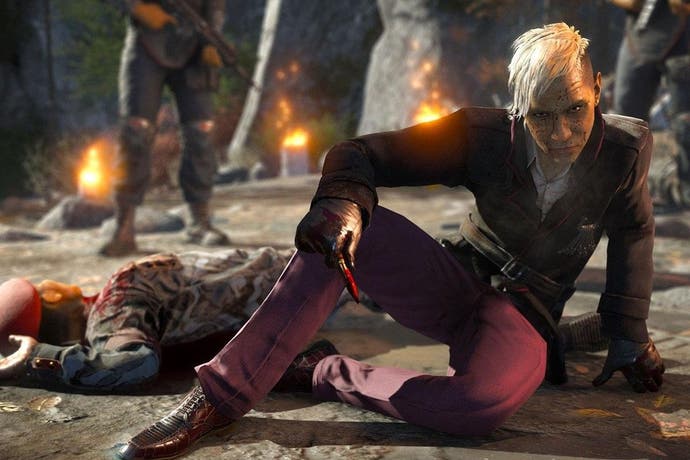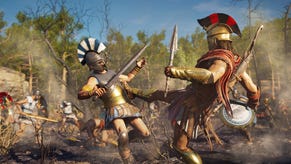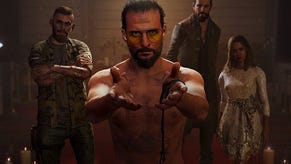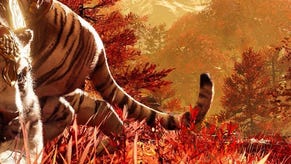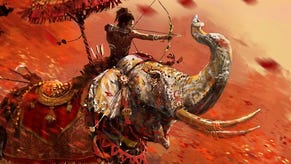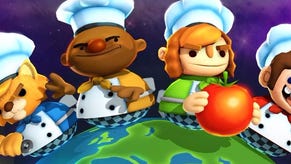How Far Cry 4 is like a Paul Verhoeven film
"We're going for that awkward intersection of serious people doing outlandish things."
Has there ever been a series as tonally diverse as Far Cry? Sure, the likes of Final Fantasy, Assassin's Creed, and BioShock have drastically changed their settings, genres, and flavours to various degrees, but the feelings they invoke remained largely the same. Far Cry, however, went from a light, goofy shooting adventure about aliens on a tropical island to a sombre dissection of the African blood diamond trade, to a satirical take on the modern open-world shooter, to an extraordinarily goofy parody of "edgy" 80s sci-fi culture. Now, with Far Cry 4, Ubisoft has settled on a tonally ambiguous Himalayan adventure that rests in the nebulous place between drama and comedy, light and dark, satire and sincerity. It's not a place often explored by the medium and that makes it as difficult to decipher as its wildly enigmatic cover.
Its opening cinematic - revealed at Microsoft's E3 press conference - depicts a blond man in a magenta suit slaughtering a bus full of passengers awaiting entry into the fictitious country of Kyrat. Rather than kill the shocked player character, he offers him a hug then suggests that he's a party guest. "You and I are gonna tear s*** up!" he exclaims as The Clash's "Should I Stay or Should I Go?" bleeds its way onto the scene, lending the proceedings something of an upbeat, exciting edge. It's a beguiling opening to a game that bewilderingly blends shockingly matter-of-fact violence in a war-torn region with the cartoonish theatrics and talking villain of a Quentin Tarantino movie. I'm reminded of a Paul Verhoeven film like Robocop where it's simultaneously extremely dark while also just too extraordinary to be taken solely on face value. Lots of games blend humour and drama, but it's usually obvious when you're supposed to laugh and when you're supposed to cry. In Far Cry 4, it's never clear how you're supposed to react to anything.
"That's the nicest thing I've heard all day," laughs Far ry 4 creative director Alex Hutchinson when I tell him this. "What we're going for in a lot of ways is like the blackest form of humour where you think in your head 'oh, that's pretty funny', but we're not going for laughs. We're going for that awkward intersection of serious people doing outlandish things."
"The line I always use is 'it's okay for our characters to tell jokes, but it's not okay if they are jokes,'' he explains. "They all need to be real people in such an extreme situation that it sort of pops out the other side." I liken this to Snakes on a Plane, an example her agrees with wholeheartedly. "Exactly. But they're still people on a plane filled with snakes!"
"People would think 'is the new Far Cry about crazy people?'" Hutchinson says of the game's outlandish cover. "And it's like 'I wouldn't peg him as crazy. I'd say he's so rich and powerful that he's in a different orbit.' The goal with that opening cutscenes is he's covered in blood, but he's like 'we should ride elephants and shoot guns! You wanna shoot guns?!' We had all these different versions of this cutscene where he was much more excited. What we wanted with this cutscene was [this sense of] he wants to be your buddy."
"I really like the idea that if you bought Far Cry [4], and you looked on the back and you saw shotguns, rideable elephants, helicopters, and blowing s*** up, what you're secretly thinking is 'let's go tear some s*** up!' So when the villain invites you to do that, I really like the awkward 'Yes, I do kinda want to do that. Yes... but no.' That moment of 'that's kind of why I'm sitting here, but I don't think I'm meant to do it with you.' That kind of awkward intersection of the player's desire, and the character's desire, and the antagonist's desire."
Far Cry 2 director Clint Hocking once coined the term "ludonarrative dissonance," which was a fancy way of describing when a player's motive differed from the character's. For example, in Sleeping Dogs, the character wants to prevent crime in Hong Kong, while the player wants their version of an undercover agent to run around in their underwear wreaking havoc. Hutchinson is going for this enigmatic tone because he wants a narrative just serious enough that it can have an emotional impact, but just outlandish enough to not be at odds with the fact that it's a game about murdering hundreds of people while riding elephants. Serious people doing outlandish things, indeed.
"In the end, your player story is of reclaiming space," Hutchinson says, drawing a parallel between the game's narrative theme and player-driven mayhem. "Your personal narrative as well will be linked with that... You won't have the sort of saving your buddies on one hand, but secretly conquering the country and taking over... All these things should intersect and lead you to your eventual conflict toward Pagan."
"The best story in Far Cry is the story you tell yourself and finding ways to get out of the way of that is kind of the goal. For me the narrative cutscenes and narrative backbone is there to give you new stuff, open the world up, then kind of get out of the way. To give flavour to it. But it's kind of more of a scenario than a linear plot."
This is all well and good, but how will Far Cry 4 differentiate itself from the glut of other open-world Ubisoft games that notoriously follow the same template? "Far Cry's at its best when it's systemic and I think it still is the best collection of systems that allow the player to express themselves," explains Hutchinson. "So I think it's the cleanest version of that."
"I think that this time around it's the fact that you can bring your best friend along for the ride will be a huge differentiating factor," he adds, noting the game's new addition to the franchise with co-op. As we've written about elsewhere, Far Cry 4's co-op will be available to those who don't even own the game, provided they download a free client first. Having played a small sample of this where I rode an elephant into a base while my partner, represented by Far Cry 3's resident troublemaker Hurk, approached things by a rickety one-man helicopter. Too bad it was his first time flying, so he instantly crashed his vessel before gliding in with his wingsuit. The crazy nut.
Co-op is probably Far Cry 4's biggest addition to the franchise, but it's not the only one. Rideable elephants are certainly a marquee feature, though they don't alter the dynamic as much as you may think. Still, they can toss foes around with their trunks, while you ride shotgun on their backs with an actual shotgun, which is always fun - if not the most effective method of liberating an enemy outpost. The new helicopter is definitely a standout new toy that's slightly harder to manoeuvre than you'd expect - in a good way. Its height advantage is obvious, but it's also a very clear target for your foes, so it's not exactly the win-all vehicle you might think. This makes it no less fun to use, however.
Far Cry 4's mechanic and design additions are pretty natural evolutions of the series with co-op joining new vehicles and animals to ride. But its most interesting new feature is also its most subtle as its slight variation on tone gives this latest rendition in Ubisoft's open-world franchise the kick it needs to set itself apart from the dreary glut of open-world clones flooding the marketplace. On the surface this might look like the Far Cry you've played before, but even in its fifth iteration (I'm counting Far Cry 3's standalone DLC Blood Dragon here), this series is finding ways to keep things fresh, exciting, and audacious. Now, how 'bout you and me hop on some elephants and tear s*** up?
